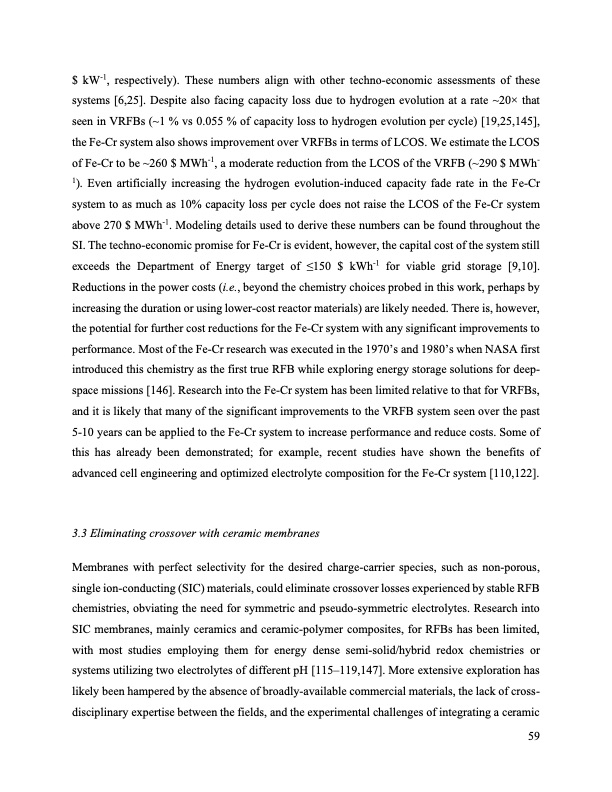
PDF Publication Title:
Text from PDF Page: 059
$ kW-1, respectively). These numbers align with other techno-economic assessments of these systems [6,25]. Despite also facing capacity loss due to hydrogen evolution at a rate ~20× that seen in VRFBs (~1 % vs 0.055 % of capacity loss to hydrogen evolution per cycle) [19,25,145], the Fe-Cr system also shows improvement over VRFBs in terms of LCOS. We estimate the LCOS of Fe-Cr to be ~260 $ MWh-1, a moderate reduction from the LCOS of the VRFB (~290 $ MWh- 1). Even artificially increasing the hydrogen evolution-induced capacity fade rate in the Fe-Cr system to as much as 10% capacity loss per cycle does not raise the LCOS of the Fe-Cr system above 270 $ MWh-1. Modeling details used to derive these numbers can be found throughout the SI. The techno-economic promise for Fe-Cr is evident, however, the capital cost of the system still exceeds the Department of Energy target of ≤150 $ kWh-1 for viable grid storage [9,10]. Reductions in the power costs (i.e., beyond the chemistry choices probed in this work, perhaps by increasing the duration or using lower-cost reactor materials) are likely needed. There is, however, the potential for further cost reductions for the Fe-Cr system with any significant improvements to performance. Most of the Fe-Cr research was executed in the 1970’s and 1980’s when NASA first introduced this chemistry as the first true RFB while exploring energy storage solutions for deep- space missions [146]. Research into the Fe-Cr system has been limited relative to that for VRFBs, and it is likely that many of the significant improvements to the VRFB system seen over the past 5-10 years can be applied to the Fe-Cr system to increase performance and reduce costs. Some of this has already been demonstrated; for example, recent studies have shown the benefits of advanced cell engineering and optimized electrolyte composition for the Fe-Cr system [110,122]. 3.3 Eliminating crossover with ceramic membranes Membranes with perfect selectivity for the desired charge-carrier species, such as non-porous, single ion-conducting (SIC) materials, could eliminate crossover losses experienced by stable RFB chemistries, obviating the need for symmetric and pseudo-symmetric electrolytes. Research into SIC membranes, mainly ceramics and ceramic-polymer composites, for RFBs has been limited, with most studies employing them for energy dense semi-solid/hybrid redox chemistries or systems utilizing two electrolytes of different pH [115–119,147]. More extensive exploration has likely been hampered by the absence of broadly-available commercial materials, the lack of cross- disciplinary expertise between the fields, and the experimental challenges of integrating a ceramic 59PDF Image | Bringing Redox Flow Batteries to the Grid

PDF Search Title:
Bringing Redox Flow Batteries to the GridOriginal File Name Searched:
Rodby-krodby-phd-chemE-2022-thesis.pdfDIY PDF Search: Google It | Yahoo | Bing
Salgenx Redox Flow Battery Technology: Salt water flow battery technology with low cost and great energy density that can be used for power storage and thermal storage. Let us de-risk your production using our license. Our aqueous flow battery is less cost than Tesla Megapack and available faster. Redox flow battery. No membrane needed like with Vanadium, or Bromine. Salgenx flow battery
| CONTACT TEL: 608-238-6001 Email: greg@salgenx.com | RSS | AMP |